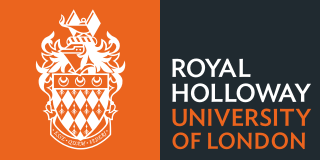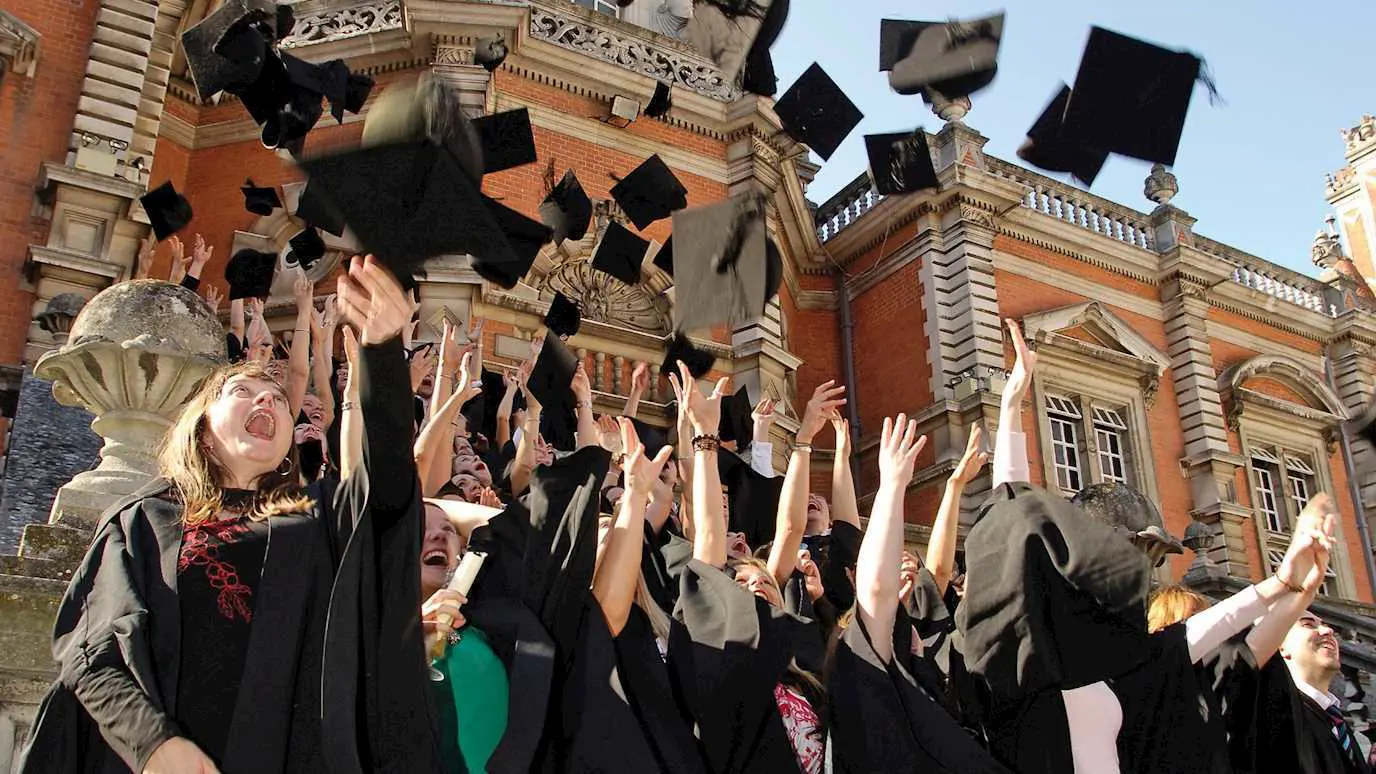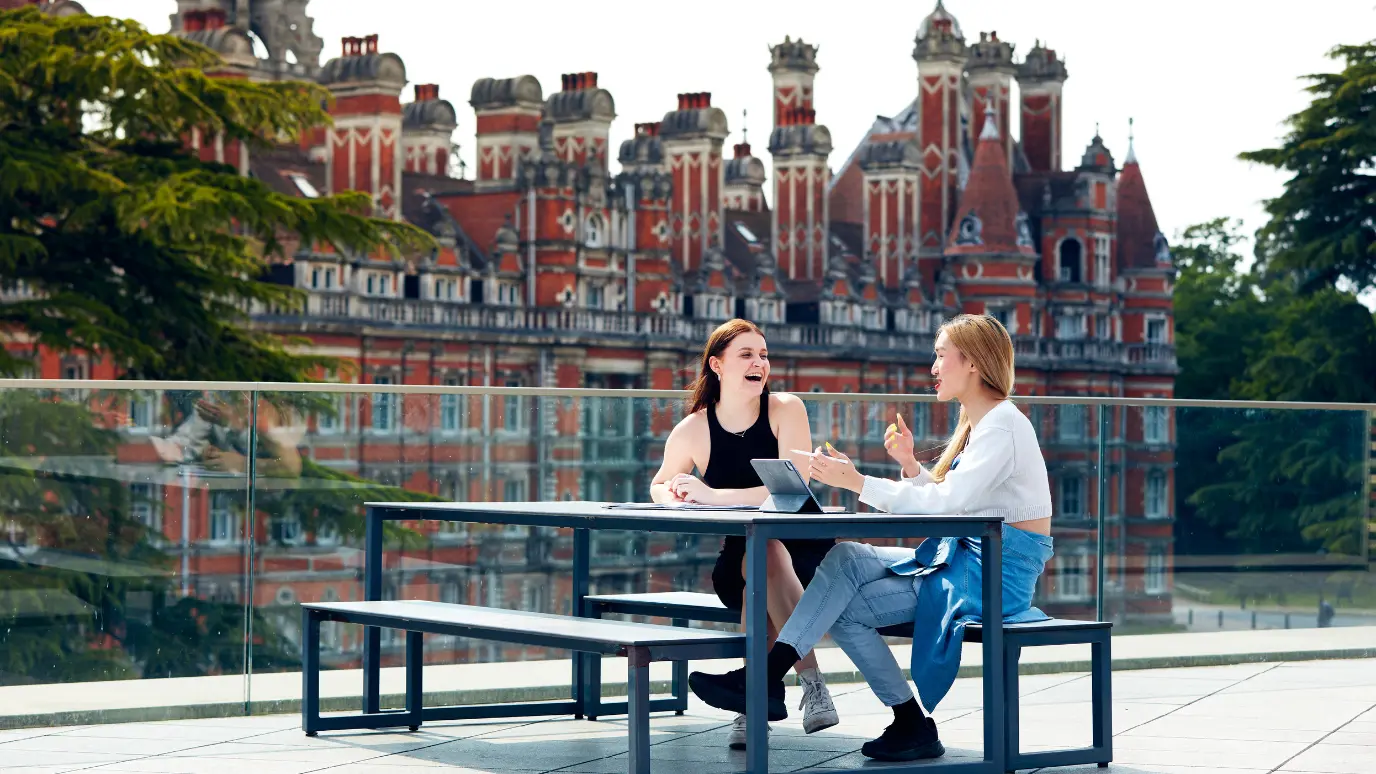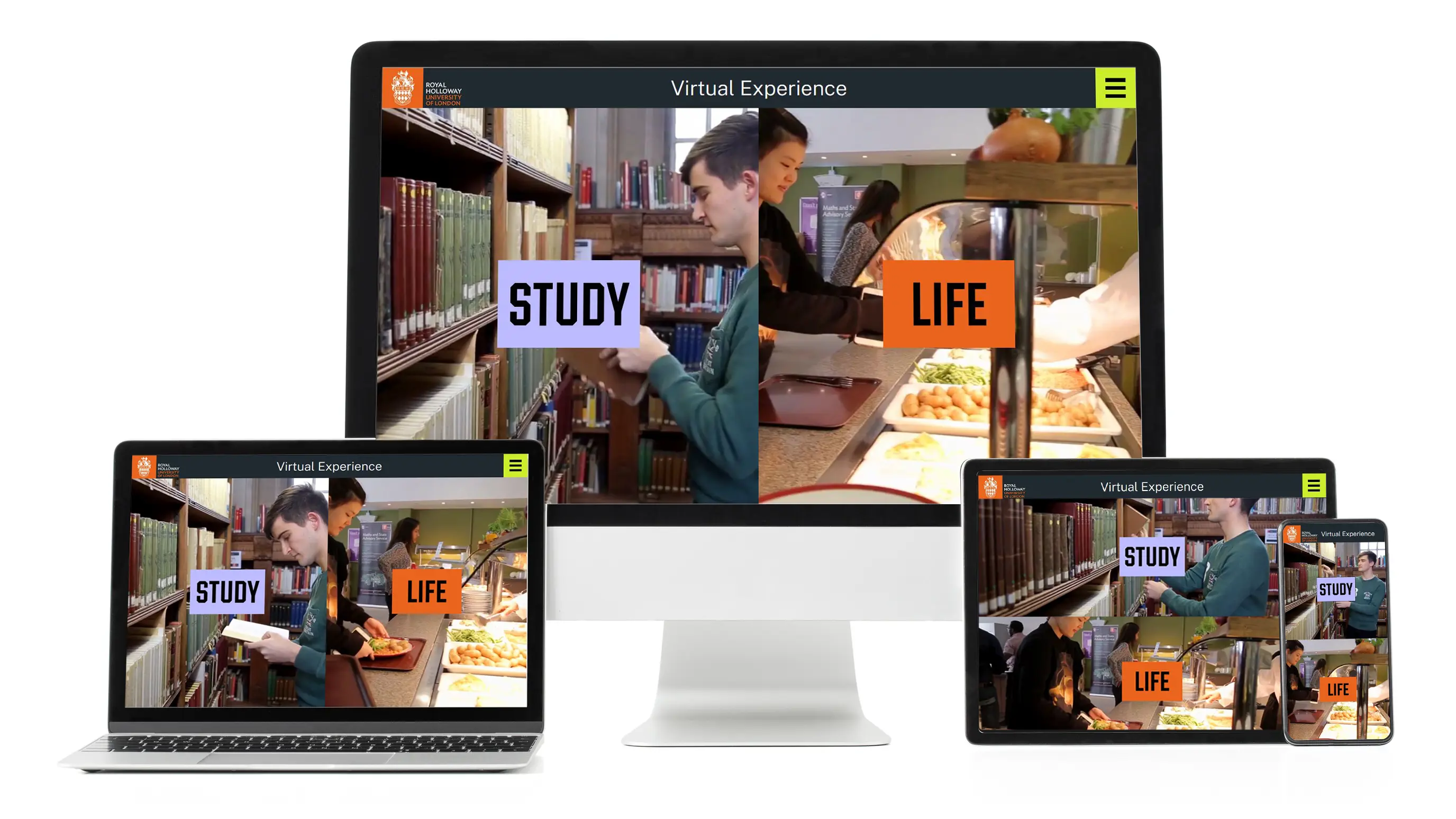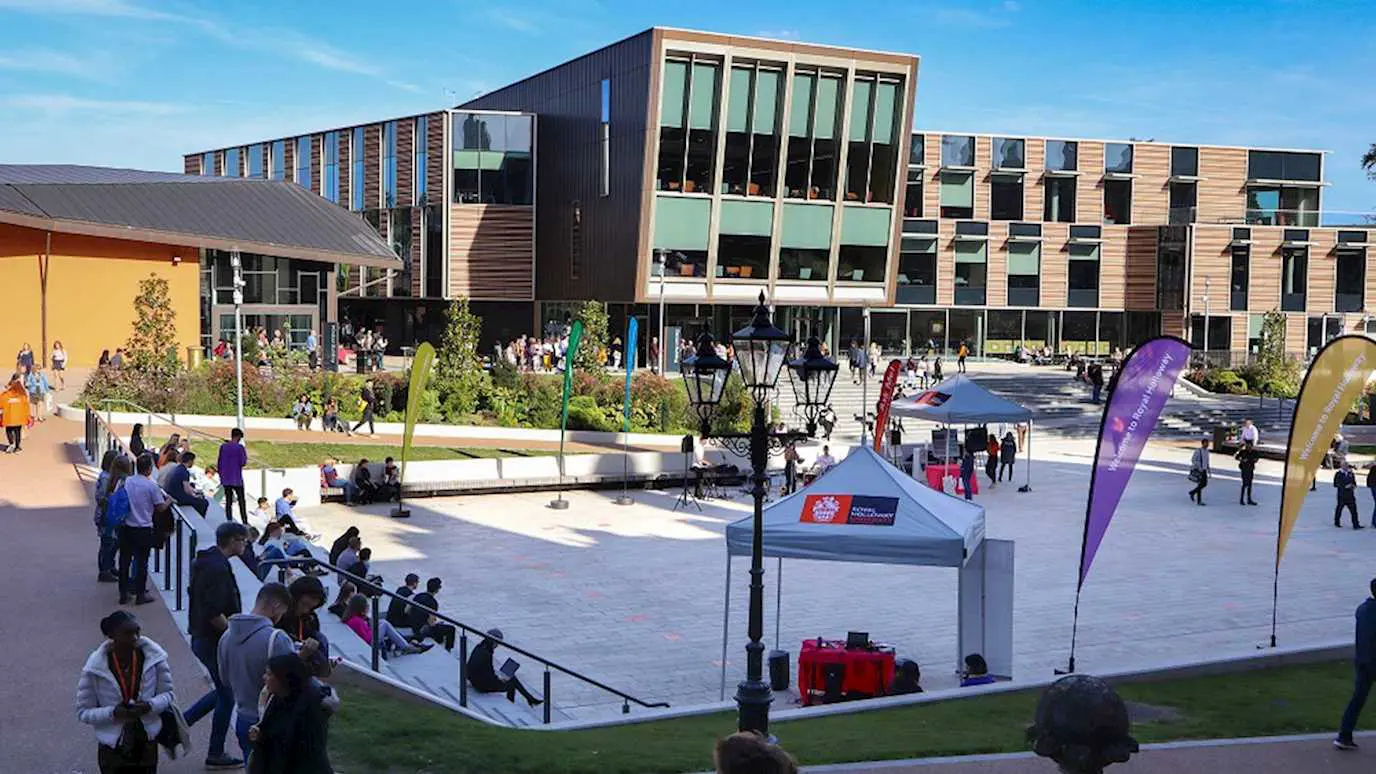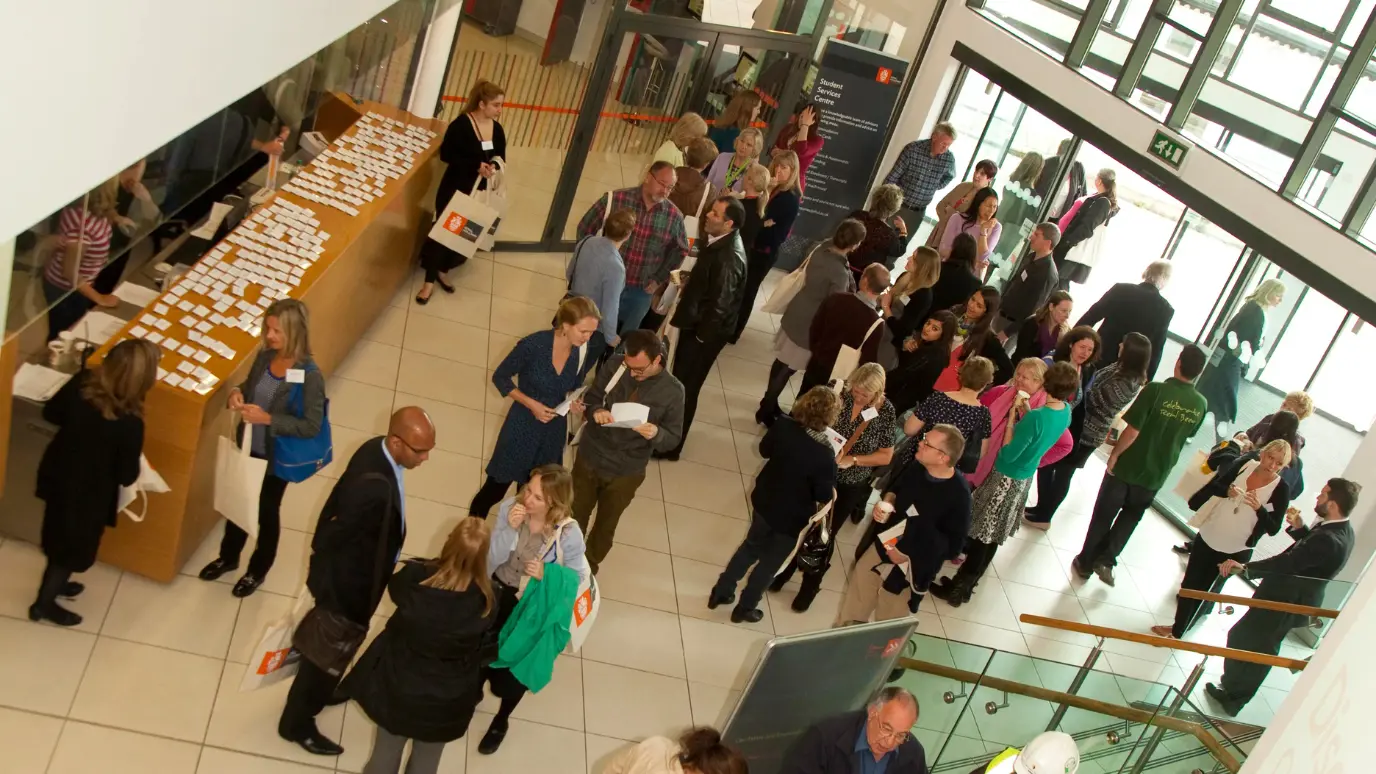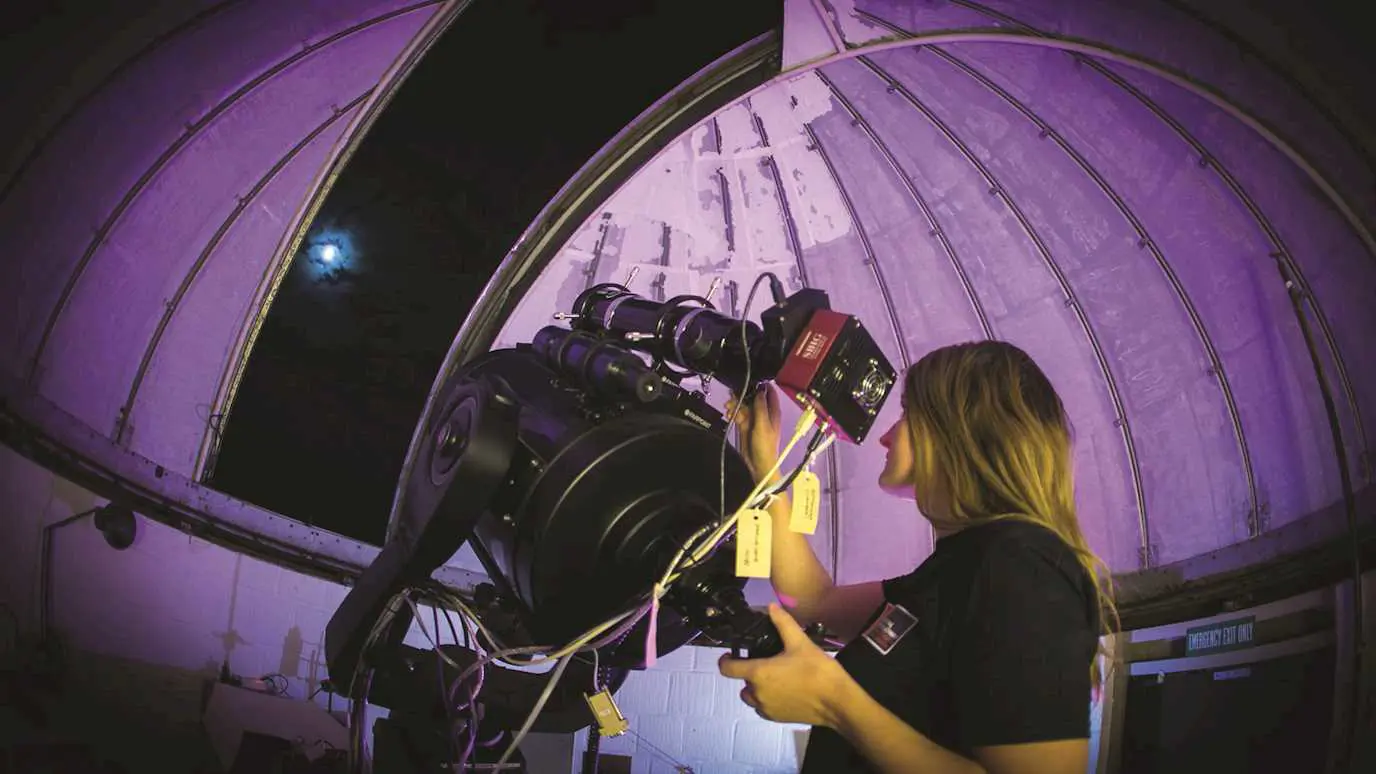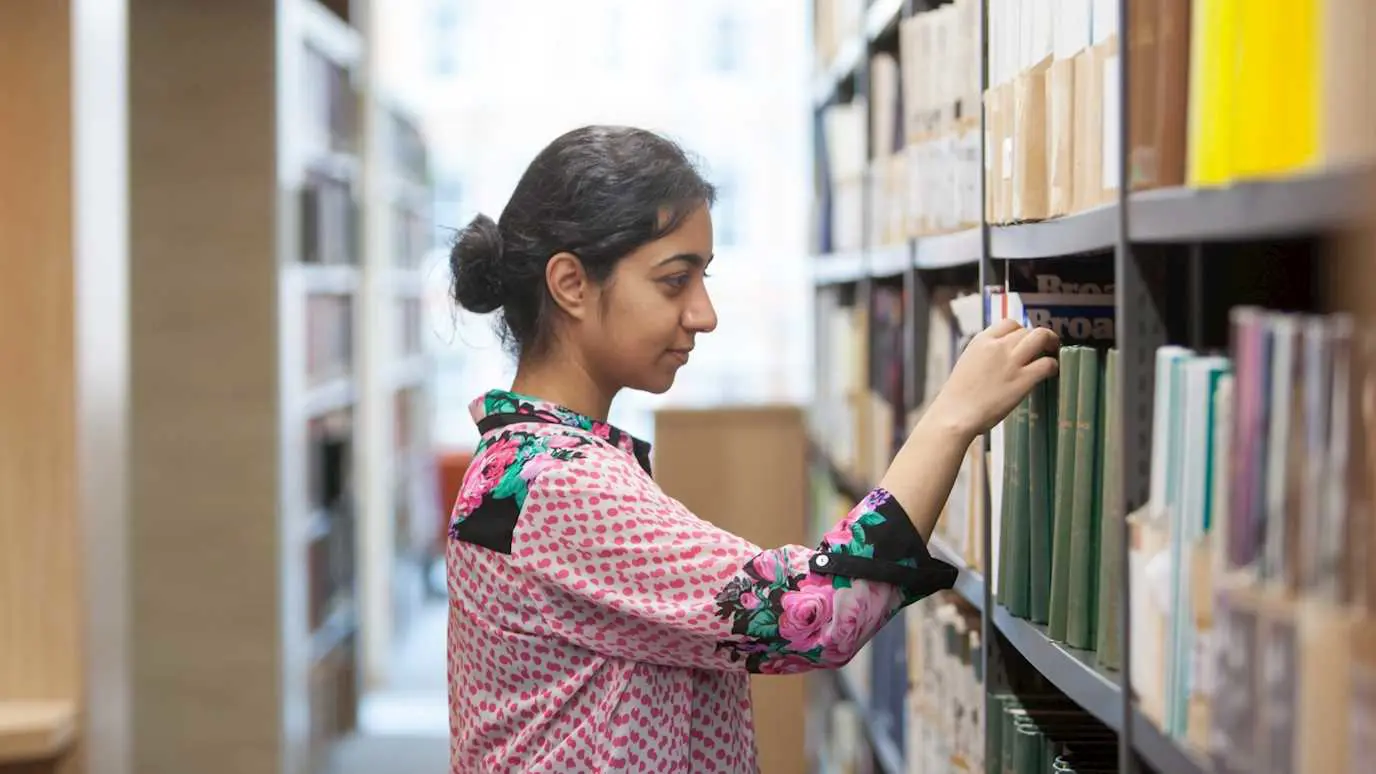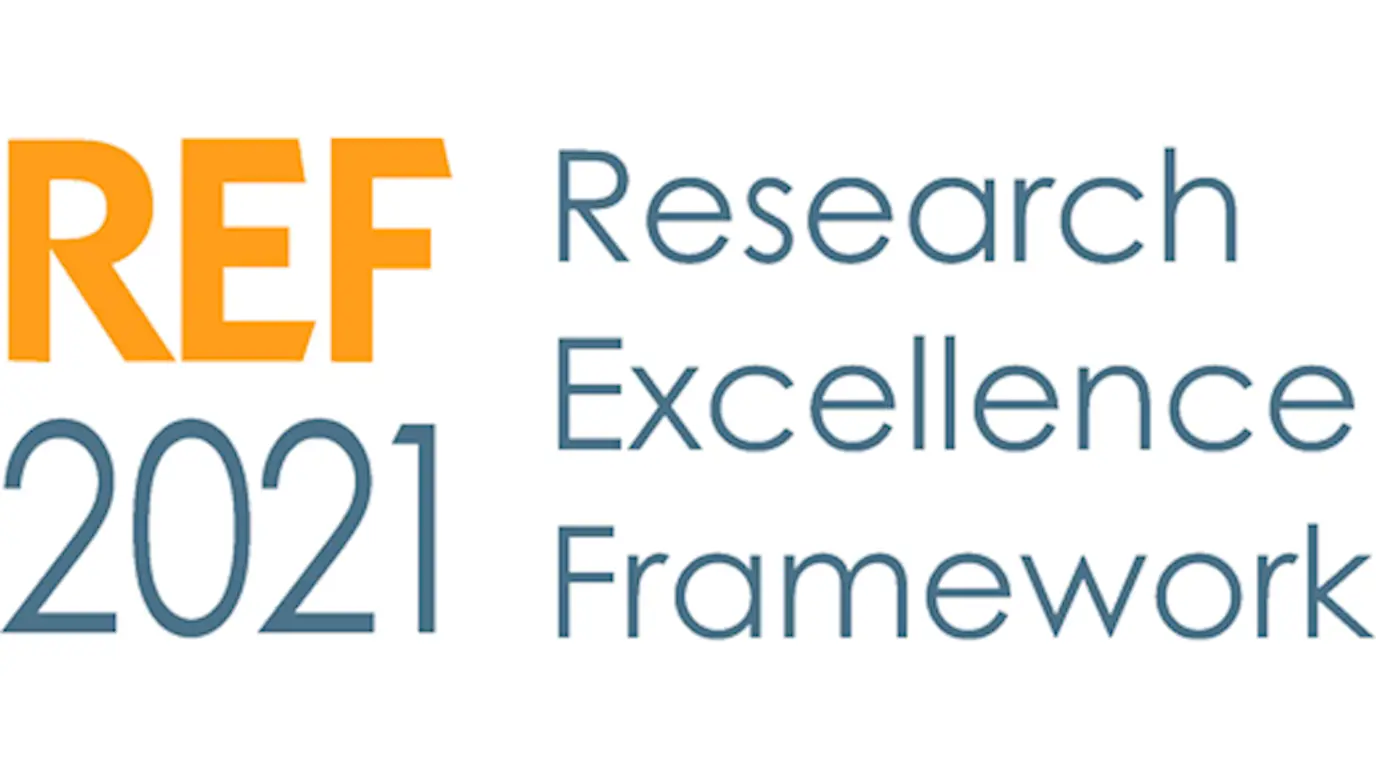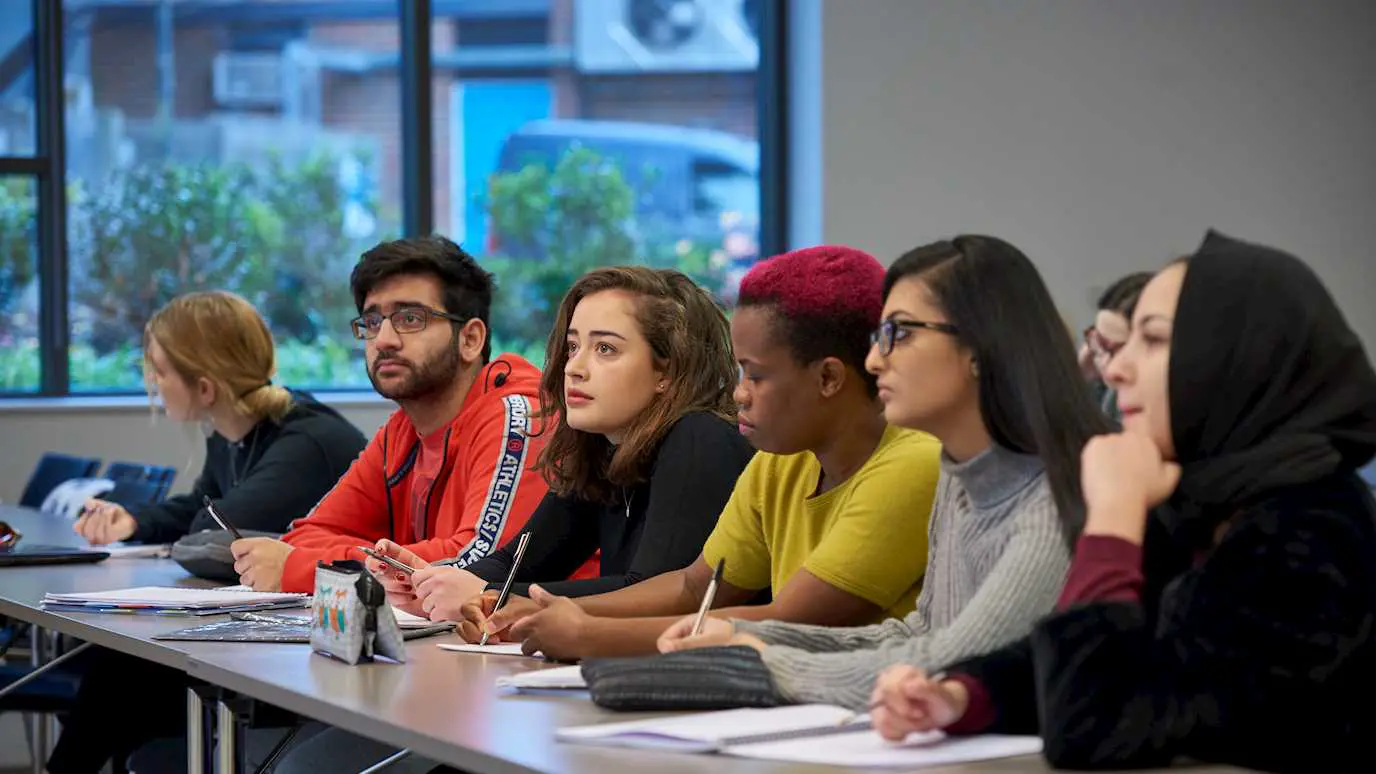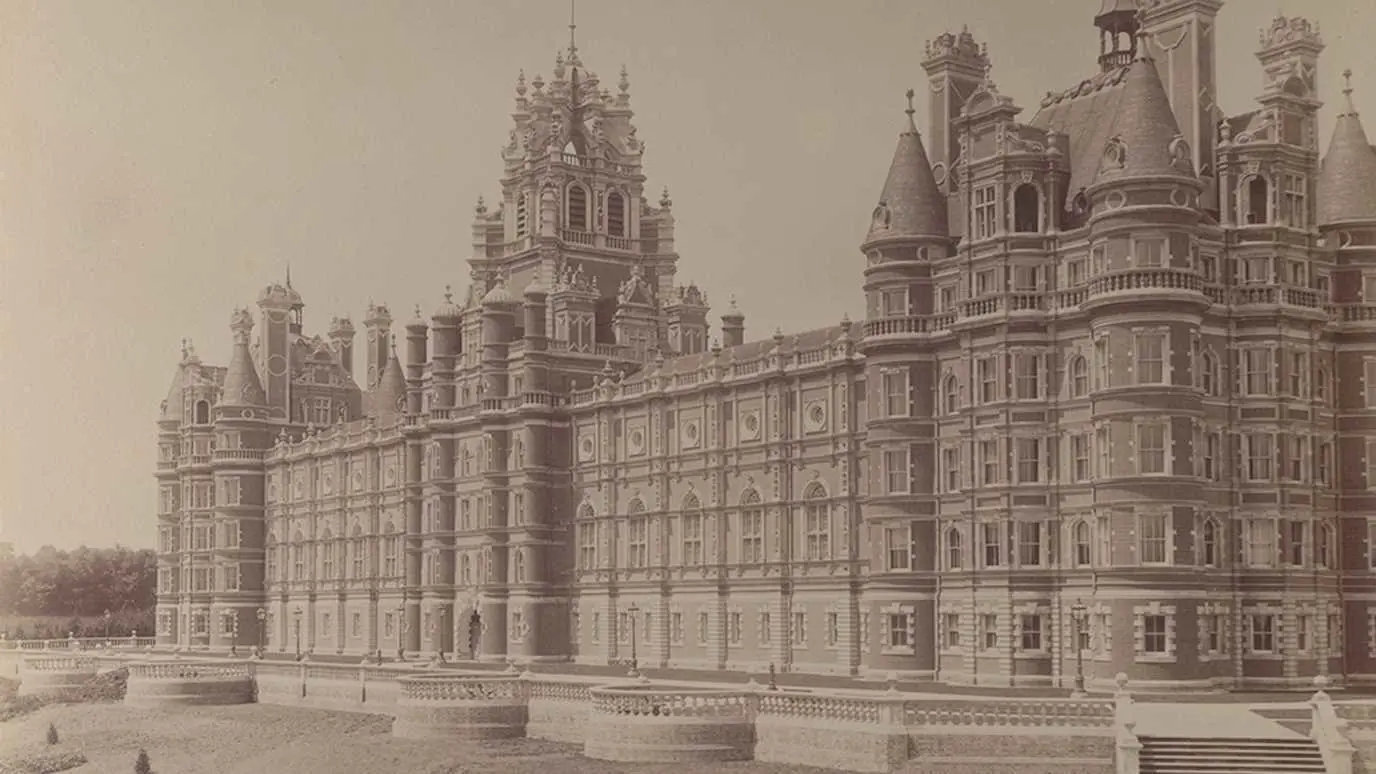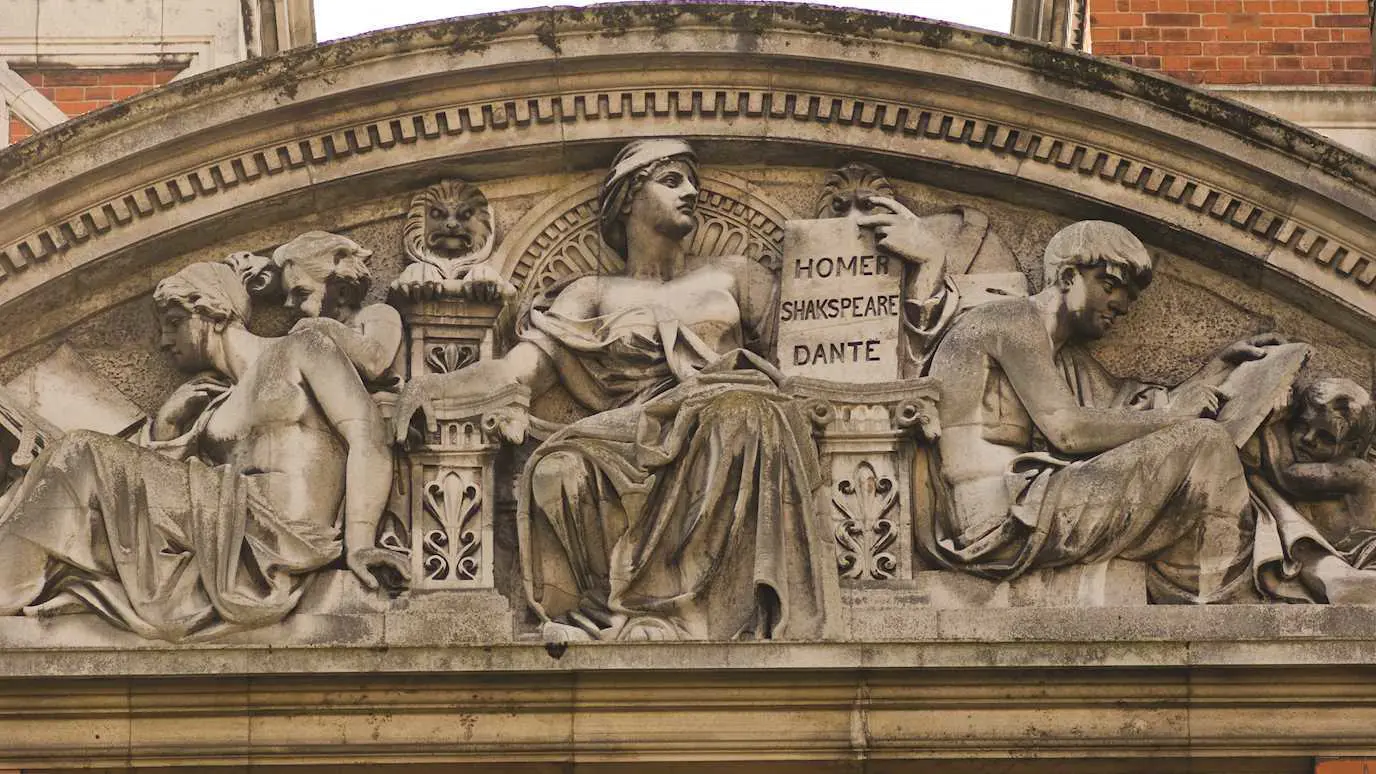Key information
Duration: 3 years full time
UCAS code: F3W3
Institution code: R72
Campus: Egham
The course
Physics with Music (BSc)
Choose Physics with Music at Royal Holloway, University of London and you'll combine two of the subjects you love across three years of study. You’ll develop a wide range of skills including mathematics, experimental skills, computing, communication, composition and historical musicology, all while maximising your graduate employability with a desirable honours degree.
You'll study in one of the University of London's major centres for physics teaching and research, with research strengths including Quantum physics, condensed matter and particle physics informing our teaching. Physics is studied as the major subject, and you'll learn the mathematical, conceptual and experimental skills expected of a graduate physicist.
This degree is run jointly with the Department of Music, where our expert academics have worked hard to build excellent industry connections. You'll learn about music composition, theory and analysis, together with historical musicology, and issues that shape contemporary music, including politics, urban development, gender and globalisation.
You'll graduate with excellent employability prospects across a range of sectors, with employers valuing graduates with the diverse skillset offered by this degree.
- Physics is studied as the major subject with the addition of music as a significant component.
- This degree is run jointly with the acclaimed Department of Music at Royal Holloway
- You will learn about music composition, theory and analysis together with historical musicology and issues that shape contemporary music.
From time to time, we make changes to our courses to improve the student and learning experience. If we make a significant change to your chosen course, we’ll let you know as soon as possible.
Course structure
Core Modules
Year 1
-
In this module you will develop an understanding of how to solve problems involving one variable (either real or complex) and differentiate and integrate simple functions. You will learn how to use vector algebra and geometry and how to use the common probability distributions.
-
In this module you will develop an understanding of how to solve problems involving more than one variable. You will learn how to use matrices and solves eigenvalue problems, and how to manipulate vector differential operators, including gradient, divergence and curl. You will also consider their physical significance and the theorems of Gauss and Stokes.
-
In this module you will develop an understanding of good practices in the laboratory. You will keep a notebook, recording experimental work as you do it. You will set up an experiment from a script, and carry out and record measurements. You will learn how to analyse data and plot graphs using a computer package, and present results and conclusions including error estimations from your experiments.
-
In this module you will develop an understanding of how to apply the techniques and formulae of mathematical analysis, in particular the use of vectors and calculus, to solve problems in classical mechanics. You will look at statics, dynamics and kinematics as applied to linear and rigid bodies. You will also examine the various techniques of physical analysis to solve problems, such as force diagrams and conservation principles.
-
In this module you will develop an understanding of the macroscopic properties of the various states of matter, looking at elementary ideas such as ideal gases, internal energy and heat capacity. Using classical models of thermodynamics, you will examine gases, liquids, solids, and the transitions between these states, considering phase equilibrium, the van der Waals equation and the liquefaction of gases. You will also examine other states of matter, including polymers, colloids, liquid crystals and plasmas.
-
In this module you will develop an understanding of the building blocks of fundamental physics. You will look at Einstein’s special theory of relativity, considering time-dilation and length contraction, the basics of quantum mechanics, for example wave-particle duality, and the Schrödinger equation. You will also examine concepts in astrophysics such as the Big Bang theory and how the Universe came to be the way we observe it today.
-
This course aims: 1. to develop basic music-analytical literacy, 2. to introduce basic concepts concerning counterpoint, harmony, melody and form that underpin the analysis of music, 3. to put these concepts into practice in the analysis of pieces from a variety of repertories. The course addresses the contrapuntal, melodic, harmonic and formal elements of tonal music. Weekly lectures, in which students are introduced to analytical concepts and then practise deploying them, through listening, score study and the completion of practical exercises, are supplemented by private study based on Moodle and recommended readings, to consolidate concepts learnt in the lectures and provide further opportunities to practise new skills.
Year 2
-
In this module you will develop an understanding of how electric and magnetic fields are generated from static charges and constant currents flowing through wires. You will derive the properties of capacitors and inductors from first principles, and you will learn how to analyse simple circuits. You will use complex numbers to describe damped harmonic oscillations, and the motion of transverse and longitudinal waves.
-
In this module you will develop an understanding of the mathematical representation of physical problems, and the physical interpretation of mathematical equations. You will look at ordinary differential equations, including linear equations with constant coefficients, homogeneous and inhomogeneous equations, exact differentials, sines and cosines, Legendre poynomials, Bessel's equation, and the Sturm-Liouville theorem. You will examine partial differential equations, considering Cartesian and polar coordinates, and become familiar with integral transforms, the Gamma function, and the Dirac delta function.
-
In this module you will develop an understanding of the physical properties of solids. You will look at their structure and symmetry, concepts of dislocation and plastic deformation, and the electrical characteristics of metals, alloys and semiconductors. You will examine methods of probing solids and x-ray diffraction, and the thermal properties of photons. You will also consider the quantum theory of solids, including energy bands and the Bloch theorem, as well as exploring fermiology, intrinsic and extrinsic semiconductors, and magnetism.
-
In this module you will develop an understanding of how computers are used in modern science for data analysis and visualisation. You will be introduced to the intuitive programming language, Python, and looking at the basics of numerical calculation. You will examine the usage of arrays and matrices, how to plot and visualise data, how to evaluate simple and complex expressions, how to sample using the Monte Carlo methods, and how to solve linear equations.
-
In this module you will develop an understanding of quantum mechanics and its role in and atomic, nuclear, particle and condensed matter physics. You will look at the wave nature of matter and the probabilistic nature of microscopic phenomena. You will learn how to use the key equation of quantum mechanics to describe fundamental phenomena, such as energy quantisation and quantum tunnelling. You will examine the principles of quantum mechanics, their physical consequences, and applications, considering the nature of harmonic oscillator systems and hydrogen atoms.
-
In this module you will develop an understanding of thermal physics and elementary quantum mechanics. You will look at the thermodynamic properties of an ideal gas, examining the solutions of Schrödinger’s equation for particles in a box, and phenomena such as negative temperature, superfluidity and superconductivity. You will also consider the thermodynamic equilibrium process, entropy in thermo-dynamics, and black-body radiation.
Year 3
-
-
-
In this module you develop an understanding of the properties of light, starting from Maxwell’s equations. You will look at optical phenomena such as refraction, diffraction and interference, and how they are exploited in modern applications, from virtual reality headsets to the detection of gravitational waves. You will also examine masers and lasers, and their usage in optical imaging and image processing.
-
In this module you will develop an understanding of how James Clerk Maxwell unified all known electrical and magnetic effects with just four equations, providing Einstein’s motivation for developing the special theory of relativity, explaining light as an electromagnetic phenomenon, and predicting the electromagnetic spectrum. You examine these equations and their consequences, looking at how Maxwell’s work underpins all of modern physics and technology. You will also consider how electromagnetism provides the paradigm for the study of all other forces in nature.
Optional Modules
There are a number of optional course modules available during your degree studies. The following is a selection of optional course modules that are likely to be available. Please note that although the College will keep changes to a minimum, new modules may be offered or existing modules may be withdrawn, for example, in response to a change in staff. Applicants will be informed if any significant changes need to be made.
Year 1
-
This course aims: 1. to develop basic music-analytical literacy, 2. to introduce basic concepts concerning counterpoint, harmony, melody and form that underpin the analysis of music, 3. to put these concepts into practice in the analysis of pieces from a variety of repertories. The course addresses the contrapuntal, melodic, harmonic and formal elements of tonal music. Weekly lectures, in which students are introduced to analytical concepts and then practise deploying them, through listening, score study and the completion of practical exercises, are supplemented by private study based on Moodle and recommended readings, to consolidate concepts learnt in the lectures and provide further opportunities to practise new skills.
-
The aim of this course is to develop students' awareness of music theory through practical exercises and musical analysis. Through practical exercises that focus on musical literacy as well as aural awareness, students develop the ability to identify and analyse the musical parameters of metre, rhythm, pitch, harmony, counterpoint and form. In-class exercises may focus on listening, whereas exercises for self-study or small-group work may include written exercises. Tasks set for private study between classes provide a basis for students to continue their own practical training throughout their musical careers.
-
This course introduces students to some fundamental techniques of music composition. The precise topics taught may change depending on the research interests of the staff responsible for teaching the course, but typically include:
• Soundworlds and scale formations
• The vertical dimension: chords and simultaneities
• The horizontal dimension: melody and voice leading
• Developments in rhythm
• Developments in harmonic vocabulary and tonalities
• Form in contemporary composition
• Acoustic timbre and texture
-
This course gives students the opportunity to practise the art of musical composition and develop skills in independents creative work. The precise topics taught may change depending on the research interests of the staff responsible for teaching the course, but typically include:
• Writing for solo instrument or voice with accompaniment
• Writing for small chamber ensemble
• Introduction to media and film music
• Studio techniques
-
This course introduces a wide range of repertories within the history of music. It stimulates students to relate features of musical compositions and performances to their wider historical contexts and gives students a fundamental knowledge of specific musical cultures. It provides students with opportunities to develop skills in research and information retrieval and in critical reading of primary and secondary literature, to receive formative feedback on those skills, and to build a foundation for higher-level study. The course will offer students a conceptual map of musical styles, composers and practices by introducing them to a wide chronological range of repertories, from early music to music of the twentieth century. It will emphasise questions of change, interaction and transmission through the study of specific forms and repertories in their historical context. Lectures will be designed around major repertorial moments (e.g. Stravinsky in 1910) or problems (e.g. the post-Beethovenian symphony), to bring together questions of form, style, performing practice and historical context.
-
This course introduces concepts underlying the historical and critical study of music. It enables students to begin thinking critically about the priorities that underlie historical texts from different intellectual traditions and stimulates them to relate features of musical compositions and performances to wider historical contexts. It provides students with opportunities to develop skills in research and information retrieval and in critical reading of primary and secondary literature, to receive formative feedback on those skills, and to build a foundation for higher-level study. This course introduces students to the different kinds of historical question that we can ask about music, and interrogates some of the terminology and categories frequently used in the secondary literature (e.g. canonisation, reception, tradition, nationalism, exoticism, the work concept). Case-studies are used to illuminate specific topics and problems in the historiography of a wide variety of musics.
-
This course introduces students to the socio-cultural contexts, functions, philosophies, techniques, and organising principles of a variety of musics of the world; musics from at least three continents will be studied. These musical traditions will be approached from both theoretical and practical perspectives, also giving a variety of opportunities for hands-on experience. Course content will vary from year to year according to staff interests, availability of musicians to provide workshops, and to ensure freshness of approach. A typical curriculum might cover the following regions and theoretical themes:
- World Music - Introduction (culture, contact & concepts)
- South America: Andes to Amazon (exchange)
- Africa: Jaliya and Mbira (the musician)
- Indonesia: Sundanese Gamelan (temporal organisation)
- North India: The Classical Tradition (improvisation)
- Papua New Guinea: The Kaluli (music and ecology)
- Iran: The Persian Classical Tradition (music & religion).
-
This course introduces students to a range of key debates and issues in contemporary musicology and to a range of key issues concerning music in the contemporary world. It encourages students to think about music’s relation to social and cultural contexts and introduces them to unfamiliar musical styles and repertoires as well as broaden understanding of those closer to home. It hones students’ skills in reading a wide variety of critical and theoretical writing about music. This course will survey some of the key contemporary issues in music that have arisen from the changes of the modern world, as well as contemporary debates in musicology. The twentieth century in particular has seen a transformation of musical cultures across the world, and this course looks at a range of the issues and controversies that have emerged as a result. The study of music has broadened to include many more social, cultural and political. This course will introduce students to truly contemporary ways of studying music, combining approaches and issues traditionally associated with musicology, ethnomusicology and popular music studies, divisions which are becoming increasingly blurred. Lecture topics may include:
• Ideas of ‘authenticity’ in music
• Value judgements about music
• Protection and preservation of music
• Heritage and revivals
• Music and tourism
• New forms of fusion and hybridity
• The idea of ‘world music’.
• Music and identity
• Music and gender
• Music and race
• Music and nationalism
Year 2
-
In this module you will create a mixed portfolio of compositions and develop skills in independent creative work. You will be encouraged to pursue your own individual approach to writing music with guidance from the course tutors alongside a series of group lectures.
-
This module introduces students to the principles of orchestration: examine and compare techniques and approaches to the discipline; help to develop further technical skills in musical notation; aid in the development of students' creative imagination; give students the opportunity to practise the art of orchestration for themselves.
-
This module aims to provide students with the technical skills, confidence, and abilities to direct choral and orchestral forces in rehearsal and performance. The practical aspect of the course will consist of regular workshops teaching skills of baton technique and/or hand gesture, as well as communication and rehearsal skills. All students will be expected to sing or play an instrument to form ensembles for practical sessions. The theoretical part of the course comprises lectures on aspects of preparation of scores, organisation of rehearsals, the understanding of vocal techniques and warm-up exercises, understanding the instruments of the orchestra, the programming of repertoire, and the interpretation of music from different periods and genres.
-
With a focus on commercial music, this module will cover the essential techniques necessary to compose music using a computer. This will include strengthening your technical knowledge as well as harmonic, melodic and rhythmic strategies for making compelling music. We will look at methods of programming and designing sounds, combining, for example, the simulation of acoustic ensembles and digital instruments in ways that will prepare you for professional practice. We will look at soundtrack composition, library music and contemporary pop production.
-
This is an introductory course exploring jazz in its historical, theoretical and practical developments. It aims to expose students to the major historical periods of jazz and their associated musical characteristics. It also addresses important social and political influences that have fed into the making of the genre and its different scenes. A small component of the course will be dedicated to basic jazz theory and practice. There will also be critical consideration of meta-narratives in the making of jazz as a musical canon.
-
From the arrival of the blues in Britain, to America's invasion by the Beatles: American and British popular musics and musicians have maintained a relationship of exchange, convergence and divergence. This module considers popular music in post-war British and North American culture from the blues revival and skiffle in the 1950s to current pop hits through shared patterns of production, dissemination and consumption between the two regions. In addition to acquainting students with the musicians and musical features that define important styles and genres of popular music, lectures will situate musical developments within broader social contexts of race, class, gender, politics, and economics. Through the lectures and readings students will also acquire knowledge of and familiarity with a range of methodologies and theoretical approaches for studying popular music.
-
This course aims to develop practical, technical and theoretical competence, in solo work and also as an ensemble member, in particular Korean percussion traditions (chiefly – samulnori, but also nong-ak and pungmul). It is assumed that the students enrolling on the course will be near-beginners, but opportunities may arise for the use of existing instrumental skills (using appropriate style) in certain percussion repertoires.
-
-
This module explores some key issues in the aesthetics of European music over the last 200 years. It examines different ways in which questions of musical meaning and value have been dealt with in the context of philosophical aesthetics, including theories of the nature of music, its capacity for expression and representation, its political function, and its relation to the natural and social world. It approaches each topic in three ways to develop: (a) an understanding of the historical development of aesthetic concepts from the late 18th century to the present; (b) a capacity to articulate and critique contemporary aesthetic debates about music; (c) an ability to relate these ideas to specific musical examples.
-
This course will consider Mozart’s operas both individually and as part of a recognised corpus. Naturally, some works will receive greater consideration than others, but there will be considerable scope for students to follow and to nurture their own interests. An especial focus will be the variety of ways in which the operas may be considered. Historical context may perhaps enjoy a particular privilege, but an integral part of the course will be to ask how historical study might be combined with analytical, dramatic, and reception-based perspectives, amongst others.
-
Issues in Sound, Music and the Moving Image introduces analytical and critical approaches to the soundtracks of moving-image media. Each session of the module focuses on a particular critical issue, aesthetic practice, or genre, such as ‘Classical Hollywood’ film music of the 1930s-40s, or the use of preexisting music in film. The module offers the opportunity to gain an understanding of key historical developments surrounding the use of music in moving-image media, to develop students' knowledge of the technologies involved in adding sound and music to such media, to explore the use of music within the broader sonic design of moving-image texts, and to investigate the development of music’s function in creating, or enhancing, ‘meaning’.
-
This module explores music’s role in the social and political upheavals in London between 1650 and 1700. During Oliver Cromwell’s Commonwealth, music was banned from most public venues. Then with the Restoration of King Charles II in 1660, music was reinstated at court and used as royal propaganda. Music returned to churches and theatres, with a rich culture of public concerts developing. Italian and French musicians flocked to London, and women were permitted to perform music in public for the first time.
-
Music is seen across the globe as something that transcends the mundane or has special powers, from the ability to move people emotionally (capitalised on by film-makers and advertisers), to the ability to put people in trance or to heal sickness, to a route to stardom and idolisation, to a means of seduction. Music has been used consciously in many political and nationalist movements and may be tightly controlled by certain regimes. Sometimes less obvious is music’s role in inscribing or subverting gender norms or distinctions of class or status. This course examines a range of these ways in which music holds power and importance in society and culture. It focuses in particular on music’s performative nature, its embodied nature, and its social and communicative nature. It refers to musical genres, practices and cultures from across the world, involving familiar and unfamiliar territory.
-
Taking as its basis an essay by Wagner, What is German?, this course will consider some of the claims made for German music, vocal and instrumental, in the context of broader political and intellectual developments. From Johann Joachim Winckelmann’s Hellenism (a key moment in the ‘tyranny of [ancient] Greece over Germany’ and Mozart’s German operas, through the (perceived) centrality of German music in the Romantic and modernist eras, to the difficulties of writing and considering German music following the ‘German catastrophe’ of National Socialism and the Second World War, continuities and disruptions will be considered.
-
This course aims to give students a wide-ranging understanding of music, performing arts and gender in different periods and different parts of the world, including Europe. It aims to introduce students to theoretical approaches to the study of gender through richly comparative case studies that will include western classical music as well as musical cultures from other parts of the world. The course will also develop the analytical and writing skills of students.
-
Year 3
-
This module aims to give students an overall view of the generation, transmission, storage and usage of energy (conventional and renewables). This course also examines the relationship between energy production, politics, economics and environmental pollution, particularly as regards to global warming.
Course Content:
Generation, transmission, storage and supply of energy. Conventional energy sources: fossil fuels and nuclear fission. Renewable sources of energy: fusion, hydroelectric, solar-thermal and solar-electric, wind, wave and tidal. Physics of the climate: energy and radiation, greenhouse effect, climate models, global warming. Experimental methods for measuring global temperatures and greenhouse gas emissions. Choice of an energy source for the UK taking into account technical, economic, political and environmental considerations. -
-
The course introduces students to the mathematical areas of Complex Analysis, Matrix Theory and Linear Transformations, and Group Theory, and enables students to apply related advanced mathematical formalisms and methods to formulate and solve physics problems. More specifically, the following topics are covered: Complex Analysis: holomorphic functions; power series; logarithms; isolated singular points; complex integration; Cauchy theorem and integral formula; Laurent series; Cauchy residue theorem and applications of contour integration; Matrix Theory and Linear Transformations: fundamentals of matrix theory; unitary diagonalisation; vector spaces and linear transformations; matrix representations, equivalence and similarity; inner product, norm, orthonormal bases, dual space, bra-ket notation; Group Theory: fundamentals of group theory; crystal lattice symmetries; Lie groups and Lie algebras; reducible and irreducible group representations.
-
-
-
This module covers formal aspects of Quantum Mechanics: Wavefunctions, principles of superposition, interference, state vectors and bra-ket notation (Dirac notation), delta function. Compatible observers, simultaneous measurement and commuting operators. Expansion postulate and complete sets of states. The generalised uncertainty relations. Matrix Representation of states and operators. Time dependent Schrödinger equation, expectation values, Hermitian operators, eigenstates, time evolution of operators. Periodic potential; Bloch theorem. Step-operator/ladder operator approach to the harmonic oscillator, derivation of energy eigenvalues and wavefunctions (explicit forms for n = 0, 1).
The Hydrogenic Atom: Solution of the non-relativistic Schrödinger equation for an electron in the field of a stationary nucleus in spherical polar coordinates, obtain normalised eigenfunctions. Energy levels, angular momentum quantum numbers and their allowed values.
Angular Momentum: Review of commutation relations, eigenvalues and eigenfunctions of angular momentum operators, generalised angular momentum, step operator techniques in angular momentum theory; spectrum of angular momentum eigenvalues. Rules for combining angular momenta in general. Representation of spin ½ operators by Pauli matrices, magnetic moments, Stern-Gerlach experiment.
Approximate Methods: Time independent perturbation theory for non-degenerate system to second order in the energy; to first-order for degenerate systems. Examples. Variational principle, He ground state example. WKB approximation. Further examples of applications of quantum mechanics to atomic, nuclear and solid state physics: spin-dependent interactions, interaction of a hydrogen atom with a strong uniform external magnetic field, the stark effect, anharmonic oscillator.
Identical Particles: Exchange symmetry for a system with identical fermions or bosons; derivation of the Pauli principle. Independent particle model of He, singlet and triplet states, exchange interaction.
Simple time-dependent systems: Time dependent perturbation theory, interaction of a hydrogen atom with an oscillating electric field. Superposition of states of different energies. Electron in a magnetic field. Time evolution of entangled states of two spin 1/2 particles with total spin zero. Transition to a continuum; density of states, Fermi’s golden rule. -
This module covers the physics of elementary particles and the experimental techniques of particle physics: Energy loss processes, particle detectors, accelerators, spin-off applications. Strange particles, quantum numbers, the simple quark model. Heavy quarks. Leptons and lepton number. Electroweak unification, W and Z bosons, the Higgs mechanism, QCD.
Extended topics selected from: deep inelastic scattering, supersymmetry, beyond the Standard Model, dark matter, Neutrino oscillations, applications to industry and medicine. -
This module covers the physics and applications of metals and semiconductors, to enhance problem solving skills and self study skills.The Course deals with three main parts: electronic structure, transport in metals and semiconductors, and collective excitations. In the first part, the topics to be covered are: electrons in a periodic potential (Bloch waves; Fermi surface, density of states, periodic band structure, van Hove singularities), nearly free electron model (perturbation theory, band gap , reduced, extended, repeated zone scheme), tight-binding method, bandwidth, effective mass, holes, examples of elemental and compound semiconductors, direct and indirect band gap, typical band structures including Si, Ge, and GaAs, kp method, intrinsic and extrinsic semiconductors. In the second part, dealing with electric conduction, the topics are: charge carriers in semiconductors (detailed balance of charge carriers, impurity levels, temperature dependence of the chemical potential and charge carrier concentration), Drude model of conduction in metals and semiconductors, electrical transport (including Hall effect for one and two carrier types, diffusion currents, Einstein relations); semiclassical model of electron dynamics in metals, inertness of filled bands; response to a DC electric and uniform magnetic field (electron and hole orbits, cyclotron effective mass, open orbits), orbit quantisation (Landau levels, quantum oscillations including de Haas-van Alphen effect). In the third part, dealing with excitations and correlations, the course covers: optical properties (dielectric function), particle-hole excitations, plasma oscillations, and screening in metals.
-
-
-
This course aims to introduce the ideas of general relativity. To present an overview of the mathematical implementation of general relativity. To provide students with practical tools for using the theory to describe gravitational/cosmological phenomena.
-
On this module you'll understand very early cosmology and the connection with particle physics. It covers: Particle Physics: review of standard model, simple use of Feynman diagrams to estimate cross-sections and decay rates._x000D_
Cosmology: the Friedmann equations, history of the early universe, photon/baryon ratio and the matter/antimatter imbalance, primordial nucleosynthesis, decoupling of matter and radiation, dark matter, the cosmic microwave background, inflation._x000D_
Cosmic rays: detection, composition and energy spectrum, origin. _x000D_
Neutrino astrophysics: neutrino oscillations; solar, atmospheric and supernova neutrinos._x000D_
_x000D_ -
In this module you will carry out independent research providing specialist insights into a topic of your choice from the field of ethnomusicology, film studies, historical musicology, performance studies, or theory and analysis. You will look at digital sources, secondary literature, and archive material on your chosen theme, and critically engage with new thinking in musicology. You will be guided by a supervisor who will advise on the planning, organisation, development and presentation of your dissertation, which will be between 13,000 and 15,000 words in length.
-
The learning objective is to write a detailed essay on a topic of a technical, analytical or theoretical nature relating to music.
You will undertake an extended piece of academic work at the level appropriate to the final year of an undergraduate degree programme, carried out independently under the guidance of a supervisor, and laying the foundations for possible further work in the field at postgraduate level.
-
This module develops students' knowledge of advanced compositional techniques with particular focus on structure, harmonic control and the manipulation of rhythmic and melodic material. It provides opportunities to practise the art of musical composition and to develop skills in independent creative work and increases students' awareness, knowledge and understanding of issues related to contemporary composition practice in a variety of contexts. Developing on areas covered in MU2213 Composition Portfolio, the module will provide a framework for you to further explore the possibilities in your own compositional method. You will complete a structured portfolio that will properly demonstrate your increased awareness, knowledge and understanding of contemporary art music and related compositional issues. You will be assisted in acquiring a deeper confidence in experimenting with a range of compositional methods and techniques whilst being encouraged to explore the possibilities of your own compositional voice in the hope that this trend will continue into your professional life. During workshops you will be given the opportunity to have your work rehearsed and recorded by professional musicians. It is hoped that through these workshops you will discover more about the possibilities of instrumentation and the many practical compositional issues facing composers today. You should also seek to develop your own opportunities for the performance of your music in order to develop your confidence and professional activity.
-
This module explores some key issues in the aesthetics of European music over the last 200 years. It examines different ways in which questions of musical meaning and value have been dealt with in the context of philosophical aesthetics, including theories of the nature of music, its capacity for expression and representation, its political function, and its relation to the natural and social world. It approaches each topic in three ways to develop: (a) an understanding of the historical development of aesthetic concepts from the late 18th century to the present; (b) a capacity to articulate and critique contemporary aesthetic debates about music; (c) an ability to relate these ideas to specific musical examples.
-
This course will consider Mozart’s operas both individually and as part of a recognised corpus. Naturally, some works will receive greater consideration than others, but there will be considerable scope for students to follow and to nurture their own interests. An especial focus will be the variety of ways in which the operas may be considered. Historical context may perhaps enjoy a particular privilege, but an integral part of the course will be to ask how historical study might be combined with analytical, dramatic, and reception-based perspectives, amongst others.
-
Issues in Sound, Music and the Moving Image introduces analytical and critical approaches to the soundtracks of moving-image media. Each session of the module focuses on a particular critical issue, aesthetic practice, or genre, such as ‘Classical Hollywood’ film music of the 1930s-40s, or the use of preexisting music in film. The module offers the opportunity to gain an understanding of key historical developments surrounding the use of music in moving-image media, to develop students' knowledge of the technologies involved in adding sound and music to such media, to explore the use of music within the broader sonic design of moving-image texts, and to investigate the development of music’s function in creating, or enhancing, ‘meaning’.
-
-
This module explores music’s role in the social and political upheavals in London between 1650 and 1700. During Oliver Cromwell’s Commonwealth, music was banned from most public venues. Then with the Restoration of King Charles II in 1660, music was reinstated at court and used as royal propaganda. Music returned to churches and theatres, with a rich culture of public concerts developing. Italian and French musicians flocked to London, and women were permitted to perform music in public for the first time.
-
Music is seen across the globe as something that transcends the mundane or has special powers, from the ability to move people emotionally (capitalised on by film-makers and advertisers), to the ability to put people in trance or to heal sickness, to a route to stardom and idolisation, to a means of seduction. Music has been used consciously in many political and nationalist movements and may be tightly controlled by certain regimes. Sometimes less obvious is music’s role in inscribing or subverting gender norms or distinctions of class or status. This course examines a range of these ways in which music holds power and importance in society and culture. It focuses in particular on music’s performative nature, its embodied nature, and its social and communicative nature. It refers to musical genres, practices and cultures from across the world, involving familiar and unfamiliar territory.
-
Taking as its basis an essay by Wagner, What is German?, this course will consider some of the claims made for German music, vocal and instrumental, in the context of broader political and intellectual developments. From Johann Joachim Winckelmann’s Hellenism (a key moment in the ‘tyranny of [ancient] Greece over Germany’ and Mozart’s German operas, through the (perceived) centrality of German music in the Romantic and modernist eras, to the difficulties of writing and considering German music following the ‘German catastrophe’ of National Socialism and the Second World War, continuities and disruptions will be considered.
-
This course aims to give students a wide-ranging understanding of music, performing arts and gender in different periods and different parts of the world, including Europe. It aims to introduce students to theoretical approaches to the study of gender through richly comparative case studies that will include western classical music as well as musical cultures from other parts of the world. The course will also develop the analytical and writing skills of students.
-
-
The module will carry on with all the technological and compositional techniques and methods introduced in MU2335 Composing with Technology 1 but take a more in-depth look at them and delve much deeper into the software. We will study compositional and technological techniques from the experimental and electronica fields and from the music to moving-image repertoire, including film, TV, adverts and games etc, and build up knowledge of up-to-date practices and trends to inform work with a view to making it concordant with current music industry practices.
-
On this module you'll learn to apply the principles of quantum mechanics (developing on from courses PH2210, PH3210) to many electron atomic systems; To build quantitative models to understand and predict the behaviour of multi-electron atoms, which were introduced qualitatively in PH1920; To understand experimental spectroscopy techniques and compare with model predictions.
Course Content: Atomic transitions and selection rules. Transitions rates. Natural broadening of transition lines. Coupling to a continuum. Fermi golden rule. Doppler and collisional broadening.Magnetic properties of the atom. Magnetic dipole associated to orbital motion and to spin. Zeeman and Stark effects. Relativistic corrections and fine structure, in particular spin orbit interaction. Effect of the nucleus spin: hyperfine structure. Atomic clocks. Metrology of the hydrogen atom. Multi electron atoms. Effect of exchange interaction. Example of He.Effect of Coulomb interactions, mean field approximation (Hartree), self-consistent potential. Applications to the ground state of the multi-electron atom. Applications to the excited states of the multi-electron atom: optical transitions and Xray transitions.Spectroscopic notation. Multiplets. Landé interval rule.Introduction of the quantum model of the interaction between light and matter. Coupling to a quantized mode. Applications to quantum optics.Extension of atomic physics concepts to nuclear and molecular physics
Teaching & assessment
The course has a modular structure, whereby students take 24 course units at the rate of eight per year. Some course units are compulsory while others are elective thereby offering flexibility and choice.
Teaching in the Physics department takes place in lectures, seminars, laboratory practical classes and problem-solving sessions. Outside class-time students participate in group projects and guided independent study and have access to the college’s comprehensive e-learning facility, ‘Moodle’ where there is a variety of resources available for students.
Physics assessment is usually by two-hour examination at the end of the year. Coursework and in-class tests also contribute to the assessment of many course units. Experimental work is generally assessed by written reports or oral presentation. A minimum of six of the eight course units must be passed with a minimum score of 40 per cent each year.
Teaching in the Music department is through a combination of lectures, seminars, tutorials, or group instrumental/vocal lessons - performance modules that include individual instrumental or vocal lessons are not available on this course.
You will also have the opportunity to take part in a wide variety of musical activities supported by the department, including performances by orchestras, choirs and other ensembles. Private study and preparation are essential parts of every course, and you will have access to many online resources through Moodle. When you start with us, you are assigned a Personal Advisor to support you academically and personally.
Music assessment is carried out by a combination of examinations, which take place in the summer term, along with written papers, extended essays, assessed coursework, and a portfolio of practical work.
Entry requirements
A Levels: AAB-ABB
Required subjects:
- A-levels in Mathematics and Physics, plus a pass in the practical element of all science A-levels being taken
- A-level Music or Grade 7 Music Theory at pass
- Applicants without A-level grade A in Music or pass in Grade 7 Music Theory may be eligible for the Intensive Theory entry. This requires Music GCSE grade A/7 or equivalent, plus performance at Grade 7 level. In term 1 you will be required to take Fundamentals of Music Theory, an intensive music literacy course.
- At least five GCSEs at grade A*-C or 9-4 including English and Mathematics.
English language requirements
All teaching at Royal Holloway is in English. You will therefore need to have good enough written and spoken English to cope with your studies right from the start.
The scores we require
- IELTS: 6.5 overall. No subscore lower than 5.5.
- Pearson Test of English: 61 overall. Writing 54. No subscore lower than 51.
- Trinity College London Integrated Skills in English (ISE): ISE III.
- Cambridge English: Advanced (CAE) grade C.
Country-specific requirements
For more information about country-specific entry requirements for your country please visit here.
Undergraduate preparation programme
For international students who do not meet the direct entry requirements, for this undergraduate degree, the Royal Holloway International Study Centre offers an International Foundation Year programme designed to develop your academic and English language skills.
Upon successful completion, you can progress to this degree at Royal Holloway, University of London.
Your future career
Study Physics with Music at Royal Holloway, University of London and you'll graduate with excellent industry contacts, insider knowledge of music networks in London and specific practical skills in performance, composition and production. You'll earn a highly desirable honours degree offering excellent employability prospects across a range of sectors, and gain a diverse skillset to take into your future career.
Our recent graduates have gone on to enjoy a wide range of careers, including roles as musicians, composers and performing arts teachers, technicians, publishers, managers, lawyers and policy-makers. Follow in their footsteps and you'll gain transferable skills including communication, teamwork, time management, commercial awareness and critical thinking.
Fees, funding & scholarships
Home (UK) students tuition fee per year*: £9,535
EU and international students tuition fee per year**: £29,900
Other essential costs***: Music - £50. Physics - £55.
How do I pay for it? Find out more about funding options, including loans, scholarships and bursaries. UK students who have already taken out a tuition fee loan for undergraduate study should check their eligibility for additional funding directly with the relevant awards body.
*The tuition fee for Home (UK) undergraduates is controlled by Government regulations. This figure is the fee for the academic year 2025/26 and is shown as a guide. The fee for the academic year 2026/27 has not yet been announced.
**This figure is the fee for EU and international students on this course in the academic year 2026/27.
Royal Holloway reserves the right to increase tuition fees annually for all students. For further information see fees and funding.
*** These estimated costs relate to studying this particular degree at Royal Holloway during the 2026/27 academic year. Costs, such as accommodation, food, books and other learning materials and printing, have not been included.
